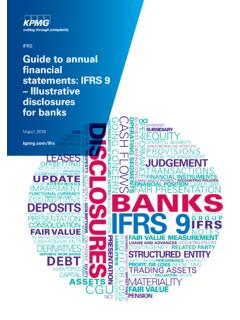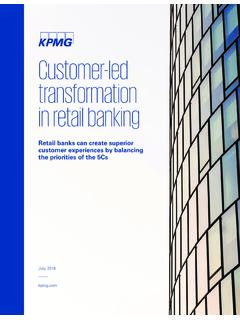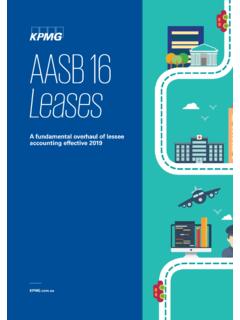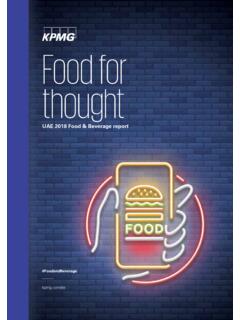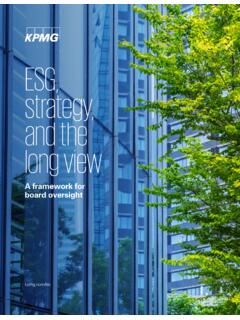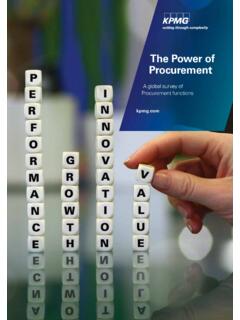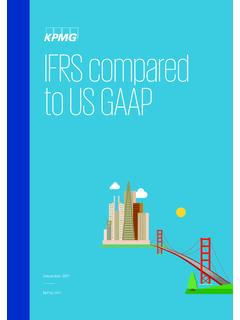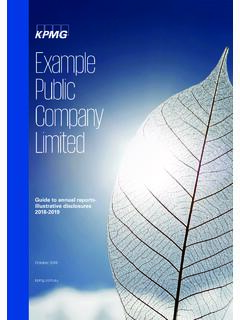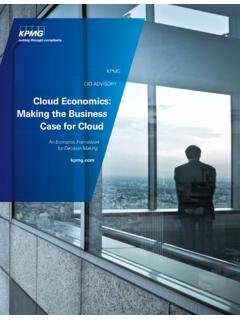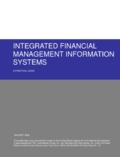Transcription of IFRS compared to French GAAP An overview - assets.kpmg
1 IFRS compared to French GAAPAN overview summaryForewordOrganisation of the publication 6 Illustrated instructions for use 71. Introduction The conceptual framework 112. GENERAL Form and components of financial statements 16 Changes in equity Statement of cash flows Fair value measurement Consolidation 28 Business combinations Foreign currency translation Accounting policies, errors and estimates Events after the reporting date Hyperinflation 493 .STATEMENT OF financial General Property, plant and equipment Intangible assets and goodwill Investment properties Associates and the equity method Joint arrangements [Not used]* Inventories Biological assets Impairment of non- financial assets [Not used]* Provisions, contingent assets and liabilities Income taxes 774.
2 Statement of profit or loss and othercomprehensive Presentation of the statement of profit or loss and other comprehensive income 84 Revenue Government grants Employee benefits Share-based payment Borrowing costs 1035. Special Leases Operating segments Earnings per share 11 Non-current assets held for sale and discontinued operations 11 Related party disclosures Investment entities Non-monetary transactions Accompanying financial and other information lnterim financial reporting Disclosure of interests in other entities Extractive activities Service concession arrangements Common control transactions and Newco formations 1376. First-time adoption of First-time adoption of IFRS 1427.
3 financial Scope and definitions Derivatives and embedded derivatives Shareholders equity and financial liabilities Classification of financial assets Classification of financial liabilities Recognition and derecognition Measurement Impairment Hedge accounting Presentation and disclosures 166 Keeping in touchKeeping in touch 168*The areas covered by this section have been reallocated to other sections due to changes in the IFRS are pleased to present this new edition of our comparison between IFRS and French accounting rules. This publication has been updated for the impacts of the new international standards related to revenue (IFRS 15), financial instruments (IFRS 9), leases (IFRS 16) and of the interpretation IFRIC 23 on tax uncertainties.
4 It also covers the impacts of the latest French accounting rules related to mergers, financial instruments and changes in accounting objective of this publication is to present an overview of main IFRS accounting principles and to highlight the main differences between those principles and French accounting do not seek to present all differences that could occur between IFRS and French accounting principles, but instead we focus on the differences that we regularly see as we deliver GAAP conversion services. Also, it should be noted that this publication is not to be used in isolation as the GAAP assessment tool for a specific publication is designed for you if you are in any of the following situations:You are interested in an overview of IFRSYou are considering implementing a transition to IFRSYou would like to better understand the IFRS entries to be recorded to prepare your reporting package for your parent companyWe hope you will find this publication useful and would be delighted to assist you with your projects involving accounting or financial reporting issues.
5 We are grateful for the assistance of the members of our Department of Professional Practice in reviewing the publication, under the supervision of Emmanuel MontagnierPartner, Global Assurance Accounting ServicesCatherine PortaPartner in charge of Global Assurance activities The provisions related to accounting for Property, Plant and Equipment that are described in this section mainly derive from IAS 16 as applicable in the European Union as at January 1st, provisions from IFRS 13, IFRS 15, IFRS 16 and IFRIC 1 may also difference exists between French accounting rules for both separate and consolidated financial statements and difference only exists between French accounting rules for separate financial statements and IFRS.
6 In consolidated financial statements prepared in accordance with French accounting rules, the acquisition costs are included in the cost of the asset as under instructions for use56 Initial recognitionProperty, plant and equipment is initially recognised at cost (which includes acquisition costs such as purchase taxes and professional fees) when control is includes all expenditure directly attributable to bringing the asset to the location and working condition for its intended cost includes the estimated cost of dismantling and removing the asset and restoring the cost includes borrowing costs, if any (see ).If payment is deferred beyond normal credit terms, the cost of the asset is the cash price equivalent.
7 MAIN DIFFERENCESWITH French ACCOUNTING RULES The notion of control is also used in French accounting rules but there are exceptions to this general principle. In separate financial statements, the acquisition costs may either be included in the cost of property, plant and equipment, which is the reference method, or expensed as incurred. [PCG art. 213-8] The cost of the asset is not affected if payment is deferred (consistent with the principle that transactions should be recorded at their face value - see ). It is possible to include borrowing costs in the cost of property, plant and equipment or not (no reference method). [Code de Commerce R123-178/2 and PCG art.]
8 213-9/1]Currently effective: IAS 16 Related standards: IFRS 13, IFRS 15, IFRS 16, IFRIC Property, plant and equipmentOrganisation of the publicationThis publication is a summary of the key provisions of IFRS and highlights the main differences with French accounting rules for separate and consolidated financial statements of companies in the industrial and commercial related to banking or insurance companies are not addressed by this publication. In particular, IFRS 17 Insurance contracts is not addressed in our publication is based on the IFRS framework as adopted by the European Union and applicable mandatorily as at January 1st, 2019, and on French accounting rules that are effective on January 1st, 2019.
9 This edition therefore includes provisions related to new international standards and interpretations related to revenue (IFRS 15), financial instruments (IFRS 91), leases (IFRS 16) and tax uncertainties (IFRIC 23).This publication does not discuss changes that are likely to be implemented in the near future in French accounting rules related to revenue recognition and preparation of consolidated financial statements. Link with Insights into IFRSThe sections in this publication match the chapters in our publication Insights into IFRS, which discusses the provisions of IFRSs and KPMG s interpretations in detail. Therefore, should you wish to know more about any section of IFRS compared to French GAAP: an overview , you can refer to the corresponding chapter of Insights into of the main differences with French accounting rulesThe main differences are highlighted in inserts labelled Main differences with French accounting rules.
10 On a particular subject, a difference may exist between French accounting rules for separate financial statements and IFRS whereas there is no difference between French accounting rules for consolidated financial statements and IFRS. In that case, it will read in separate financial before the difference is stated. In case a difference only relates to consolidated financial statements, it will read in consolidated financial before the difference is a difference is highlighted with no further precision, then it means that this difference exists between French accounting rules for both separate and consolidated financial statements and IFRS. However, some sections are relevant only for consolidated financial statements (for example, Business combinations).
